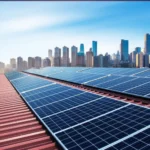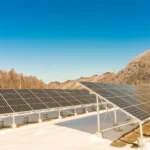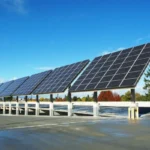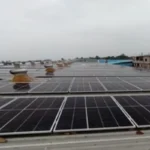Stop Losing Power: The Ultimate Guide to Solar DC & AC Cable Sizing for Max Efficiency
Stop Losing Power: The Ultimate Guide to Solar DC & AC Cable Sizing for Max Efficiency
When we are talking about 25 years of life for a Solar PV Rooftop Power Plant, Module Mounting Structure plays a crucial role. In this bog we will be discussing on Module Mounting Structures Quality and Design.
As per standards, Module mounting structure for a Solar PV Rooftop Power Plant should be designed to withstand storm condition with wind speed up to maximum 150 Kmph. But in the competitive market of Solar PV Rooftop Power plants, many installers are compromising with the quality and strength of Module mounting structures. To ensure that the structure is designed with relevant max wind speed the STAAD PRO test (simulating the conditions of wind speed to see the stress on each joint) needs to be done. It costs the installer about 5000 but to save these 5000, he takes risk with the life of the structure. For a 10 KW power plant this is significant as it amounts to Rs 0.5/w of savings for the installer.
Many installers use pregalvanized sheets and forming sections out of it rather than making sections with MS Plates and then going for hot dipped galvanizing (80 microns coating) the same to make the structure; But the process being adopted with pregalvanized sheets gives a better look and feel to the structure, saves cost and time. When somebody cuts the galvanized sheets the cut edge of the sheet does not remain galvanized and therefore when exposed to moisture and atmospheric conditions gets rusted with time reducing the strength of the structure. The difference in cost may be around Rs. 1-2/Watt, but this saving comes with the risk of damaging the power plant.
So if the Solar PV Rooftop uses best Solar PV Module and best Inverter, but margins are created out of Structure compromising quality, then there is a possibility of Solar PV Module blowing off or structure uplifting and may more in the event of a storm or with time.
So, while comparing various installers for Solar PV Rooftop System installations at your premises, you should consider the importance of module mounting structure. You need to question your installer about the size, quality and strength of the material he would be using for your Solar PV Rooftop power plant. For best results, Module mounting structure should be a Hot Dipped Galvanized structure, designed to withstand a wind speed of maximum 150 Kmph and STAAD PRO analysis should be done for that structure.
So, when you are looking for quality installation of Solar PV Rooftop power plant that will work for 25 years and more, then you surely need to consider the importance of Structure Quality and the knowledge of the installing company. Do not go for price alone, as looking for cheaper supplier may result in costly repairs at a later stage.
Mounting of structure: While designing the structure the tilt angle of the panels is an important aspect which needs to be carefully considered because if the direction of the panels on mounted structure is not on true south at an elevation equal to latitude of the site then there is bound to be loss of power.
Assuming altitude to be 30 degrees then 180 degree south will give the best results.
Modules after mounting on structure are facing west then loss shall be 17% but if it is facing east then loss could be as high as 22%. For optimum results of power generation structure design should be such that after mounting of modules, modules remain in true south at appropriate altitude angle.
Register at our website for reading more of such blogs.
Suggested Articles

Solar Sector Growth in India Slows as Investments Decline in Q1 2023
India’s solar sector experiences an investment slowdown in Q1 2023, reflecting challenges in funding and growth for renewable energy projects.

Latest MNRE List: Approved Solar Module Manufacturers
Check the latest MNRE-approved list of solar module manufacturers to ensure quality and compliance for your solar projects in India.

Latest 100 kW Solar Plant Price in Delhi | Subsidy, ROI & Payback
Thinking about installing a 100 kW solar system in Delhi? This 2025 guide breaks down the 100 kW Solar Plant Cost in Delhi, explaining price per watt, total investment, energy generation, and key benefits for industries and businesses.

Complete Guide to Solar Panel Subsidy Scheme in Haryana
Solar power is not only less expensive, but it is also the most abundant source of clean energy.

Should You Switch to Solar in India? Complete Guide
India has become a hot-selling solar market and people are interested in installing solar systems in their homes as well as in industries and factories.

UP Electricity Tariff Increase 2015-16: Rates Rise by Rs 0.40–1.00 per Unit – What Consumers Need to Know
Uttar Pradesh has increased electricity tariffs for 2015-16, ranging from Rs 0.40 to 1.00 per unit. This update explains the revised rates, the sectors affected, and what consumers need to know about the tariff hike.

Can Solar Systems Support Industrial Motors and Machines? A Complete Guide
Discover how using solar for heavy machines can power industrial equipment reliably and cost-effectively for greener operations.

How to Choose Solar Panel Mounting Structures for Home, Industry & Commercial Installations
Choosing the right mounting structure is crucial for solar panel efficiency and durability. This blog explains various types of mounting structures for residential, industrial, and commercial solar installations, including rooftop, ground-mounted, and hybrid systems, to help you make an informed decision.